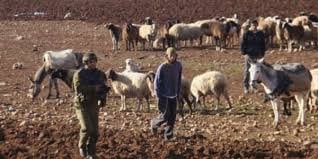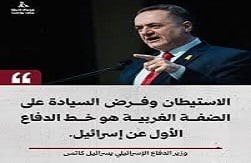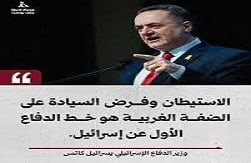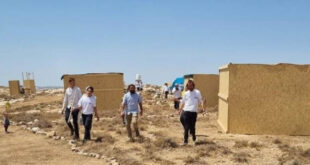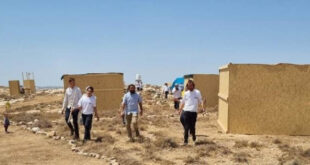By: Madeeha Al-A’raj
National Bureau for Defending Land and Resisting Settlements stated in its latest weekly report , that these days, the ‘pastoral farms’ are a popular settlement industry, they have become so in the circumstances of the brutal war waged by the occupying state against the Palestinian people in the Gaza Strip, as well as the West Bank, including East Jerusalem. They are means of seizing large areas of Palestinian land in C areas. The occupying state sponsors them through the Civil Administration and ministries, in addition to the ‘Jewish National Fund’.
The first one was established in the 80s and early 90s of the last century, including the ‘Har Sinai farm’ south of Mount Hebron, and two farms east of the Nablus city, on the lands of Rojeb, Beit Dajan, Beit Furik, Salem and Azmut villages, namely, the ‘Ibriran farm’ in the hills of the ‘Itamar settlement’, and the ‘Scali farm’ east of the ‘Elon Moreh settlement’ towards the edge of the Jordan Valley. The number overtime increased, it reached about 23 farms across the West Bank at the beginning of 2017, and by the end of 2021, and the number reached about 60 farms. Today, their number exceeds 90 farms, controlling about 650,000 dunams, or about 12% of the area of the West Bank.
According to Israeli sources, this settlement project was initiated by Zeev Hever ‘Zambish’, a man whose door is open to Netanyahu, as many say. Some observers see him as the mastermind behind the project to control Palestinian lands. This man heads the ‘Amana Group’, the main executive arm for establishing settlement outposts. The Haaretz Newspaper quoted him in an interview with the magazine ‘Nadlan Yosh’ ‘Regional Real Estate’ , as saying that ‘preserving open land is the central mission of ‘Amana’, and that ‘the main tool we use is farms’, adding that ‘the area of these farms is 2.5 times of the areas that all settlements combined occupy.”
The ‘Amana Association’ is a settlement led by Zeev Hever, who was a right-wing extremist terrorist in the Jewish underground in the early 1980s, and was convicted in 1984 for his involvement in the attempted assassinations of mayors in the West Bank in 1980. In later years, he became more influential, and the occupation state awarded him its highest official award ‘the Israel Prize’. He is now the secretary general of the association, which is responsible for building most of the violent settlement outposts in the West Bank.
According to sources, it is a powerful organization, with assets estimated at NIS 600,000,000 i.e. $158,000,000. However, it could not have brought such a colonial project to life on its own. In recent years, the occupation state has made the settlement farms an instrument of its control over the land, and has lavished them with extraordinary generosity, granting them tens of millions of shekels directly and through government ministries, local settlement authorities, the settlement division of the World Zionist Organization, and the Jewish National Fund.
Recently, the occupying state has turned the “pastoral farms” into a public project, and has begun to spend generously on them. Tens of millions of shekels are pumped into these farms directly from government ministries, local authorities in the settlements, and the Settlement Department in the Civil Administration. The occupying state is working to provide loans for their establishment, allocate contracts for grazing areas, connect them to infrastructure, finance their protection, purchase equipment and arm them, and provide them with grants such as ‘grazing grants’ and even ‘commercial investment grants’, and according to the Haaretz Newspaper, in its issue dated Oct. 13, at least 6 government ministries are participating in financing and encouraging this dangerous colonial project.
The occupying state sees the farms as a successful means of controlling the largest possible area of land with the minimum amount of manpower. In 2020-2022, the occupying state provided grants to 13 farm owners for a cumulative amount of NIS 1.6,000,000. In the Naftali Bennett government ‘2021-2022’, an annual work plan was approved for the Settlement Department, which included an item dealing with planning vital infrastructure and security elements for the young settlement ‘outposts and farms’. Under this twisted item, the department transferred NIS 15,00,000 to the shepherds’ farms in 2023, and in 2024 the budget tripled to another NIS 39,000,000, besides, 68 farms received funding in 2023 in the amount of NIS 7.7,000,000 for paving roads.
Not only the institutions of the occupying state that sponsor this dangerous settlement project, or the local authorities in the settlements or the Settlement Department of the World Zionist Organization, but the Jewish National Fund is a major supporter of this settlement project, through its participation in projects for ‘youth at risk’ that have grown in recent years as a devious and dangerous means of whitewashing farms under the cover of a social mission that provides services to rehabilitate young men, who have dropped out of school and live on the margins of society, through their presence on a farm under the auspices of an ‘educational or rehabilitation framework’. The fund works with institutions in the occupying state to grant them legitimacy that goes beyond the local context in its meaning, and in cooperation with some ministries, it transfers to them generous budgets, some of which are included in the so-called enrichment programs proposed by the Ministry of Education to schools.
Thus, the Jewish National Fund become an important supporter of this dangerous settlement project, and its main contribution, as we have noted, is centered on the so-called projects for at-risk youth on the farms. In general, the term ‘at-risk youth’ has become the focus of the policy of whitewashing the farms, beautifying their image, and marketing this image abroad as well. The placement of delinquent teenagers on these farms under the umbrella of an educational or rehabilitation framework gives the settlement outposts and farms a different image, or so the Jewish National Fund believes, as well as the institutions of the occupying state and its settlement apparatuses.
`In total, by the end of 2023, more than 200 ‘teenagers’ participated in the JNF project on dozens of farms in the West Bank. Eighty of the youth were among the beneficiaries of the NIS 1.5,000,000 that the JNF transferred to the Binyamin Regional Council in the West Bank. It transferred a larger sum, NIS 2,000,000 to ‘Artzeno’, an organization that funded training programs for 150 young people on 25 additional farms.
The occupation authorities and settler organizations are trying in vain to divert attention from the grave dangers of establishing these pastoral farms and bringing deviant youth to work and rehabilitate them, because rehabilitation is essentially based on seizing citizens’ lands and spreading chaos and terror in the Palestinian countryside.
Within the context, Professor Michal Shamai, from the Faculty of Social Work at the University of Haifa, was right in her letter to the Israeli Ministry of Welfare last March, comparing the youth living in the agricultural outposts to the phenomenon of ‘child soldiers’, who were recruited during wars in African countries. Shamai said in an interview with Haaretz that ‘this is not what the rehabilitation of at-risk youth should be like. Places like this are fertile ground for developing hatred, and hatred is not rehabilitation.”
For her part, Hagit Ofran, head of the Settlement Monitoring Team at Peace Now, said, “We have to call things as they are. The sharp rise in settler violence is directly linked to the phenomenon of the farms, whose residents bear much of the responsibility for this violence.’ Dror Etkes, founder of the Kerem Navot organization, which monitors settlements in the West Bank, also said, ‘the number of Palestinian communities that used to live in farm areas and have been evicted from their homes is constantly increasing. We are talking about 35 cases of expulsion in the past 2 years, the vast majority of them after Oct. 7.”
Within the context, the name of Yossi Dagan is once again in circulation. Yossi Dagan is a prominent member of the Likud Party, and head of the Northern West Bank Settlement Council, some describe him as an octopus in the service of settlements, and he has done a lot for this, he is credited with obtaining the necessary approvals to implement the Hawara bypass road, the bus stop at the eastern entrance to Ariel, connecting the settlements to the highest-speed internet, lighting intersections and streets, installing traffic signals at the entrances to the settlements, licensing cemeteries, and licensing the Avitar outpost.
He has strong ties with senior rabbis such as Rabbi Levanon, Daniella Weiss, head of the Nahala settlement movement, and the Amana Organization, the settlement arm of the Gush Emunim Movement. He manages a wide network of external relations with regional and international entities that he calls ‘Friends of Samaria’, which enables him to raise funds not only to support the settlements but also to arm the settlers. These ‘Samaria friends’ donated a million shekels to him to buy advanced rifles and sniper rifles with a lethal range of 700 meters to distribute to the ‘alert squads’ that include in their ranks a large number of ‘Hill Youth and Price Tag’ terrorists. He Is able to buy 500 rifles and distribute them to these terrorists in preparation for a war on the Palestinians that he had been planning for a long time.
On another level, and in a move that is not without annexation implications, MK Son Har-Melech ‘Otzma Yehudit’ called during last week’s deliberations in the Knesset’s Economics Committee on a law to amend the Negev Development Authority Law to consider the city of Hebron and Kiryat Arba part of the Negev, as stated in the Torah, as she claimed. The law stipulated that settlements that are not part of the Negev Development Authority be included in the budget of this authority. According to the law, the settlements of Hebron, South Hebron, and Kiryat Arba are to be included in the budget of the Negev Development Authority, which includes Beit Sheva, Arad, and Dimona, her call sparked outrage in the opposition.
MK Yuri Lahab ‘Yesh Atid’ said, “Open the map and you will see that Hebron is not in the Negev. Why do you want to include it now in a law? The answer is clear, because there is a budget of NIS 1.4,000,000 for projects in the Negev. You want to transfer the money of the residents of Beersheba, Arad and Dimona to Hebron and Kiryat Arba. Despite the laws that you will pass, they will not lead to a change in geography.’ MK Sachs Friedman ‘Yesh Atid’, a resident of the Negev, also said, ‘the Negev is divided into 34 local authorities that received NIS 150,000,000 last year, while the West Bank settlements received NIS 794,000,000 this year. A student in the West Bank settlements receives 30% more than a student in the Negev. You are stealing in broad daylight. MK Ofer Cassef ‘Joint List’ said, “the meaning of amending the law is annexation, which constitutes a violation of international law. Will this lead to international sanctions on Negev Development Authority.”
List of Israeli Occupation and Settlers’ Assaults over the
Last Week Documented by the National Bureau:
Jerusalem:
- Approving the seizure of 64 dunums of land in the Um Tuba village, which means the evacuation of about 30 Jerusalemite families, in which 139 citizens live, putting them at risk of forced displacement. The families submitted a petition to the occupation court to stop the ‘settlement’s seizure works carried out by the occupation authorities, after it became clear that approximately 64 dunums of the town’s lands were registered in the name of the ‘Jewish National Fund’.
- Forcing 4 brothers from the Abu Al-Hawa family to demolish parts of their homes in the At-Tur town, and citizen Saber Al-Qawasmi to demolish his home in Beit Hanina under the pretext of lacking a license.
- Attacking citizens while they were picking olives in the eastern area of the Hizma town.
Hebron:
- Injuring a female-citizen from the Aseid family in the Tel Rumeida Neighborhood in the Hebron city, after settlers attacked her and her family while they were picking olives near her home in Tel Rumeida.
- Destroying crops and water tanks after releasing their livestock in vineyards containing about 500 olive trees in the Um Sarara area near Khirbet al-Halawa in the Masafer Yatta,. They also destroyed water tanks, stole a number of them, a barbed wire fence, and iron corners surrounding the lands.
- Assaulting citizen Hassan Shanaran while he was grazing livestock in the Susiya village, stole olives, set up a tent near citizens’ homes in the Sadat al-Tha’la area, and placed occupation flags on citizens’ lands in order to control them.
- Storming the archaeological site of ‘Tel Ma’in’ in the Carmel town, and performed Talmudic rituals there.
Bethlehem:
- Detaining farmers from the Subaih family on their agricultural land in the Al-Khader town, and seized their personal IDs before releasing them.
- Stealing olives from the Subaih family’s lands in the ‘Ein Hamda’ area in the Harmalah village.
- Attacking olive pickers in the Kisan village, and threw stones at them in the ‘Wadi Jahar area’, forcing them at gunpoint to leave their land.
- Digging agricultural lands belonging to citizens from the Abu Kamil family in the housing area in Khalayel Al-Loz.
- Stealing a private vehicle belonging to citizen Ayman Yaqoub Ghazal, and solar panels belonging to the Kisan Reserve.
Ramallah:
- Forcing olive pickers to leave their lands in the village of Al-Mughayyir and fired tear gas canisters at them.
- Attacking olive pickers in the Kafr Malik village, in Khallet Suwar area and forced them to leave their lands at gunpoint.
Nablus:
- Vandalizing scores of old olive trees, and an elderly woman was injured with fractures during an attack by settlers on farmers in Qaryut village, who were forced to evacuate their lands. She was admitted to the hospital.
- Seizing olives and attacked olive pickers and their vehicles, forcing them to leave their lands In the Lubban Ash-Sharqiya village.
- Attacking olive pickers and forced them to leave their lands in the western part of the Sebastia,town.
- stealing olives In the Qablan town, others attacked olive pickers in the lands between the town and the village of Talfit, and burned a citizen’s vehicle.
- Opening fire on olive pickers south of Qusra village, on the road linking the village with Jalud village.
- Injuring 2 women, one 54 years old, and the other 42 years old, after settlers assaulted them near the Deir Sharaf Junction northwest of Nablus, they were taken to the hospital.
- Attacking olive pickers in the Sebastia and Barqa towns, sprayed them with pepper gas, forced them to leave their lands, and stole the olives.
- Preventing farmers from picking olives in the Qusra town, and attacked a European delegation to support olive pickers.
Salfeet:
- Stealing olives from the land of Firas al-Dik in the Kafr ad-Dik village, located in Khallet al-Haramiyah, olive picking equipment and two generators, and prevented him from reaching his land.
- Assaulting the young man, Yousef Salman, 27 while he was picking olives in the “al-Mughiba” area north of the Deirstiya town, and tried to kidnap him. They also pumped wastewater into lands planted with about 60 olive trees, owned by the citizen Moh’d Dahdal, 61.
- Stealing olive crops from the citizen Ayser Shamlawi on his land located in ‘Jabal al-Qibli’ and olive picking equipment in the Haris villages, while settlers from the settlements of ‘Tafuh’ and ‘Rahalim’ broke olive trees and stole their fruits in the ‘Abu al-Qaseeb area’ east of the Yasuf village.
Qalqilia:
- Bulldozing large areas of citizens’ lands in the northern area of the Azzoun town to build a barbed wire wall extending to the ‘Ma’ale Shomron settlement Junction’.
- Issuing a decision 2 months ago to seize about 15 dunums of land for military purposes. The occupation forces began implementing the decision on the ground.
- Storming the eastern side of the Amatin village, attacked citizens while they were on their land to pick olives in ‘Wadi al-Ahmar’ and fired live bullets at them, which led to the injury of 2 citizens, 49 years old with a bullet to the head, and 45 years old, with a bullet to the thigh. They were admitted to the Nablus Hospital, their injuries were described as moderate.
Jordan Valley:
- Attacking the homes of citizens in Khallet Makhul area, terrorize and provoke them, others attacked shepherds in Um al-Quba Plain, and attempted to steal a herd of livestock.
- Storming Hamamat Al-Maleh area, carry out provocative acts against citizens, armed settlers also attacked the Arab al-Kaabneh School, smashed classroom windows, and attempted to destroy surveillance cameras.
- Bulldozing lands belonging to the village of Ein al-Baida in the northern Jordan Valley, in preparation for cultivating and seizing them, noting that these lands are owned by the Tabu to citizens of the village of Ein al-Baida, and their owners use them for agriculture. The area exceeds 30 dunams, near the ‘Mikhola settlement Junction’ that located on citizens’ lands.
 المكتب الوطني للدفاع عن الارض ومقاومة الاستيطان منظمة التحرير الفلسطينية
المكتب الوطني للدفاع عن الارض ومقاومة الاستيطان منظمة التحرير الفلسطينية
